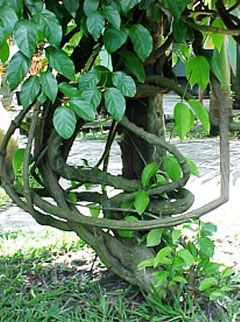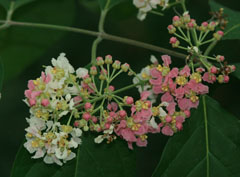 |
|
Cipó Mariri |
 |
| wikimedia.org User:Vojtech_Zavadil |
Translate this page:
Summary
Yage, Banisteriopsis caapi, is a large climbing shrub with woody stems up to 30 m long. It can be grown indoors but requires consistently moist soil. A hallucinogenic beverage can be obtained from Yage's bark, leaves and twigs. The plant is emetic and purgative, and at low doses used as a mild detoxifier. It also contains an alkaloid which has a strongly stimulatory action on the nervous system.
Physical Characteristics

 Banisteriopsis caapi is an evergreen Climber growing to 30 m (98ft) by 1 m (3ft 3in).
Banisteriopsis caapi is an evergreen Climber growing to 30 m (98ft) by 1 m (3ft 3in).
See above for USDA hardiness. It is hardy to UK zone 10.
Suitable for: light (sandy), medium (loamy) and heavy (clay) soils. Suitable pH: mildly acid and neutral soils and can grow in very acid soils.
It can grow in semi-shade (light woodland) or no shade. It prefers moist soil.
UK Hardiness Map
US Hardiness Map
Synonyms
Banisteria caapi Spruce ex Griseb. Banisteria inebrians (C.V.Morton) J.F.Macbr. Banisteria quitensis
Plant Habitats
Edible Uses
Edible Parts: Inner bark Leaves Root Stem
Edible Uses: Drink
The bark, leaves and twigs are the source of a beverage that is hallucinogenic[ 46 ] (see medical properties below).
References More on Edible Uses
Medicinal Uses
Plants For A Future can not take any responsibility for any adverse effects from the use of plants. Always seek advice from a professional before using a plant medicinally.
Emetic Hallucinogenic Purgative Stimulant
The bark, leaves and twigs are the source of a beverage that is hallucinogenic[ 46 ]. Commonly used in the Amazonian rainforest, it is used shamanically as a tool to contact the spirits and bring healing, and is also used recreationally[ 254 , 317 , 434 ]. The shoots, roots and leaves, sometimes as an admixture with other species, are used by Indians for the preparation of a hallucinogenic beverage, used for special ceremonies or the roots and stems are chewed for this purpose[ 317 ]. The dried leaves are also smoked[ 317 ]. In addition to its use as an hallucinogenic, the plant is also emetic and purgative[ 254 ]. At low doses it is used as a mild detoxifier[ 254 ]. The plant contains an alkaloid, known variously as 'telepathin', yagein' or 'banisterine', which has a strongly stimulatory action on the nervous system[ 434 ]. The bark contains beta-carboline alkaloids, including harmine, harmaline and delta-tetrahycroharmine[ 254 ]. These alkaloids stimulate hallucinations[ 254 ].
References More on Medicinal Uses
The Bookshop: Edible Plant Books
Our Latest books on Perennial Plants For Food Forests and Permaculture Gardens in paperback or digital formats.

Edible Tropical Plants
Food Forest Plants for Hotter Conditions: 250+ Plants For Tropical Food Forests & Permaculture Gardens.
More

Edible Temperate Plants
Plants for Your Food Forest: 500 Plants for Temperate Food Forests & Permaculture Gardens.
More

More Books
PFAF have eight books available in paperback and digital formats. Browse the shop for more information.
Shop Now
Other Uses
References More on Other Uses
Cultivation details
A plant of the moist tropics, where it is found at elevations from around sea level up to 1,000 metres. Suitable for growing indoors. Suitable for growing in containers.
References Carbon Farming Information and Carbon Sequestration Information
Temperature Converter
Type a value in the Celsius field to convert the value to Fahrenheit:
Fahrenheit:
The PFAF Bookshop
Plants For A Future have a number of books available in paperback and digital form. Book titles include Edible Plants, Edible Perennials, Edible Trees,Edible Shrubs, Woodland Gardening, and Temperate Food Forest Plants. Our new book is Food Forest Plants For Hotter Conditions (Tropical and Sub-Tropical).
Shop Now
Plant Propagation
Seed.
Other Names
If available other names are mentioned here
Yage, Ayahuasca, Caapi
Native Range
SOUTHERN AMERICA: Venezuela, Brazil, Bolivia, Colombia, Ecuador, Peru
Weed Potential
Right plant wrong place. We are currently updating this section.
Please note that a plant may be invasive in one area but may not in your area so it's worth checking.
None Known
Conservation Status
IUCN Red List of Threatened Plants Status : This taxon has not yet been assessed.

Growth: S = slow M = medium F = fast. Soil: L = light (sandy) M = medium H = heavy (clay). pH: A = acid N = neutral B = basic (alkaline). Shade: F = full shade S = semi-shade N = no shade. Moisture: D = dry M = Moist We = wet Wa = water.
Now available:
Food Forest Plants for Mediterranean Conditions
350+ Perennial Plants For Mediterranean and Drier Food Forests and Permaculture Gardens.
[Paperback and eBook]
This is the third in Plants For A Future's series of plant guides for food forests tailored to
specific climate zones. Following volumes on temperate and tropical ecosystems, this book focuses
on species suited to Mediterranean conditions—regions with hot, dry summers and cool, wet winters,
often facing the added challenge of climate change.
Read More
Expert comment
Author
(Spruce ex Griseb.) C.V.Morton
Botanical References
Links / References
For a list of references used on this page please go here
A special thanks to Ken Fern for some of the information used on this page.
Readers comment
| Add a comment |
|
If you have important information about this plant that may help other users please add a comment or link below. Only comments or links that are felt to be directly relevant to a plant will be included. If you think a comment/link or information contained on this page is inaccurate or misleading we would welcome your feedback at [email protected]. If you have questions about a plant please use the Forum on this website as we do not have the resources to answer questions ourselves.
* Please note: the comments by website users are not necessarily those held by PFAF and may give misleading or inaccurate information.
To leave a comment please Register or login here All comments need to be approved so will not appear immediately.
|
Subject : Banisteriopsis caapi
|
|
|
|